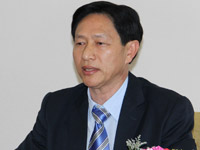Japanese composite products have construction market potential
Japanese composite products have construction market potential
With the sustained economic growth in Laos, Japanese business executives are optimistic about the market potential for their Japanese made wood and plastic composite construction materials, that offer an alternative to traditional timbers.
.jpg)
General Manager of the Japanese based ASTEC Corporation, Mr Ashii Jun told the Vientiane Times on Friday that his products have been on the market in Laos for one and a half years now, and he was satisfied with the response from customers to his company's practical products. “We have received orders from a number of customers so far,” he said.
Asked why the company selected Laos, where the of the market is small, to be the first foreign country in the region to start its outbound business, Mr Jun replied that he believed Laos is the right place for his company to test its foreign marketing strategy.
Mr Jun justified the decision to base the business in Laos, noting that the competition in the Lao market has not been so tough. He said market conditions in Laos provide them with better opportunities to introduce their products, unlike other neighbouring Asean member countries where competition is much stronger, although the markets are larger.
Competition in larger neighbouring countries is already very strong, with many companies fighting for market share, he noted. Mr Jun is optimistic that Laos' strategic location in the centre of the region will make it easier to introduce his company's products to other neighbouring countries as well.
The manager and his technical staff spoke to the Vientiane Times during a meeting in Vientiane on Friday to introduce the products to local engineers from the Association of Lao Architects and Civil Engineers.
He believes the rapid and sustained economic growth in Laos as well as development of the Asean common market will provide better future opportunities for his company's business. “We hope our business will grow along with the Lao economy,” he told the meeting through an interpreter.
Their wood- plastic composite products are 60 percent plastic compound and 40 percent wood powder. They have the appearance of real wood, offering builders another option than timber cut from the forests.
A Lao engineer who participated in Friday's meeting agreed that the products would be an option to minimise the growing threat of deforestation as it could be used instead of wood, with global timber supplies dwindling.
However, he acknowledged that their products are currently more costly compared to the price of wood, and could be unaffordable for many with financial constraints.
vientiane times
















